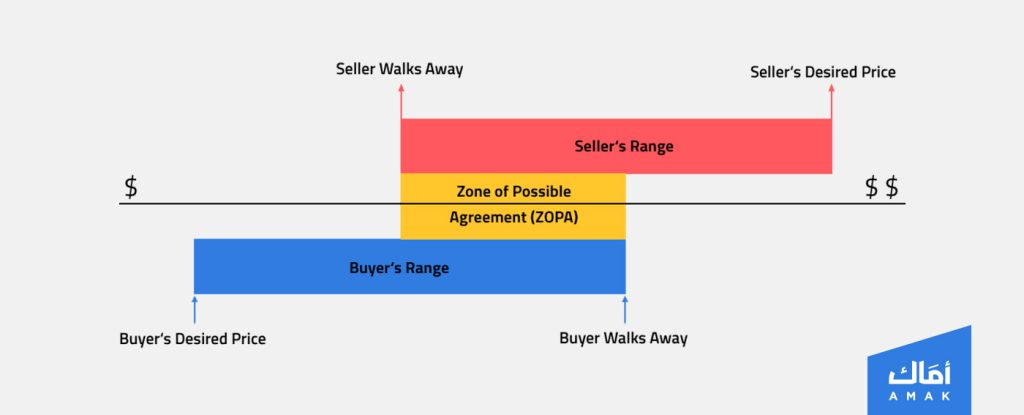All parties try to enter the negotiation process from a position of strength to get what they want, believing that weakness in the negotiation process means failure, even though a lot of research confirms that a weak negotiating position has several advantages that increase the profit opportunities in the negotiation process if strategies and the tips we have gathered in this article are applied.

The importance of negotiating from a weak negotiating position
Negotiating from a position of weakness is not always negative but contains several advantages for the weak negotiating party. This weakness would free him from any restrictions and give him the audacity to make stronger offers because he has nothing to lose, and he often ends up with a profitable deal.
The election campaign considers US President Wilson the best example. The campaign printed 3 million photos, and before distributing them to supporters, the campaign manager discovered late that they did not own the photographer’s property right, meaning that the photographer had the right to sue them and gets $1 for each photo, equivalent to $3 million in total.
This situation placed the electoral campaign manager in a weak negotiating position with the photographer, giving him two options: either accepting any amount determined by the photographer or reprinting the photos again, which meant an additional burden and time pressure.
The campaign manager sent a message to the photographer stating, “Your previous photo of President Wilson was nominated to be the official campaign photo. How much will you pay us to adopt it?, considering the great fame you will achieve after the end of the election campaign” He concluded by saying, “You have 24 hours to reply; otherwise, we will negotiate with another photographer.”
How do I negotiate from a poor negotiating position?
How often have you negotiated with a stronger party and the process ended in favour of the second party without reaching what you wanted? An employee negotiating with his manager for a vacation or a salary increase, or a buyer negotiating with a seller about a service or product he wants to buy.
Here are the top tips you can follow to turn the tables in your favour, despite your weak negotiating position:
- Make a high offer until you get what you want with the concessions you make during the negotiation process.
- Focus the discussion on topics in which you are strong.
- Provide value and benefit to the other party.
- Gather information about the party you are negotiating with.
- Make a list of your and the other party’s strengths and weaknesses.
COMMON BENEFIT AREA (ZOPA)
Zopa refers to the common benefit area as an abbreviation of The Zone of Possible Agreement, which means the negotiating area that includes the negotiating parties’ common points and enables them to reach an agreement that satisfies all parties.
It can be said that ZOPA is the area where the negotiating parties can work together towards common goals and then reach common benefits that end up with a satisfactory agreement for all the negotiating parties. A proper understanding of the mutual benefit area makes it a cornerstone of successful negotiation. Where there is ZOPA, the agreement is achieved.

The image above shows the common benefit area (ZOPA), which covers where the negotiating parties can move. It consists of the horizontal axis of the negotiating field that increases as we move from left to right along this line.
In the upper part is the negotiating field for the first party, which begins with the minimum that he accepts “walks away”, and represents his own BATNA at the same time, ending at the opposite end with the highest and ideal limit that he wants to achieve “desired price”.
In the lower part under the axis is the negotiating field for the other party, starting from the minimum “walks away” (his own BANTA and alternative plan). At the opposite end, the upper limit he accepts “desired price”.
ZOPA is located above the first party’s minimum and below the second party’s minimum; The parties in this area can move and negotiate to reach the required agreement.
But what do you do if the common benefit area is not available?
Although the presence of ZOPA(the area of common benefit) is a prerequisite for the success of the negotiation process, it is not always available. In this case, you should focus on understanding the interests of the party you are negotiating with, trying to provide the value he is seeking, as you bridge the gap of the absence of ZOPA in negotiations. But be careful to provide a significant value to the other party and not important to you at the same time.
Types of common benefit Areas (ZOPA)
The common benefit area is divided into two main types:
- Positive Common Benefit Area: It occurs when the terms offered by the first party meet the conditions agreed upon by the second party. That was the case in the negotiations between Hillary Clinton And Bernie Sanders In which the latter was in a weak negotiating position but succeeded in achieving his goals by correctly identifying their common benefit area, knowing his own and his rival’s BANTA, then building his negotiating strategy based on this information.Video
- Negative Common Benefit Area: It is when the first party’s submission does not meet the acceptance of the second party; in such case, it is impossible to reach an agreement unless one or both parties agree to modify their opinion and make concessions.
However, knowing this area and its types is not enough if your goal is a great success in the negotiation process. For this reason, here are the essential features that characterize the common benefit area (ZOPA), as knowing them increases your ability to conduct negotiations as you wish and in the manner that serves your interest.
Features of the Common Benefit Area
1- The common benefit area is non-fixed and changeable: This means that ZOPA (the common benefit area) may change, grow, decrease, or disappear entirely during the negotiation process, which requires the negotiating parties to rearrange their priorities and negotiating positions. Therefore, always be prepared to adapt to any changes that may occur.
2- The common benefit area can be formed and configured: A large part of the communication process in the negotiations revolves around the formation of ZOPA by pushing the negotiation to reach points of agreement on which the final agreement is based.
Do and don’t of negotiating from a weak position
Do not worry about your negotiating position’s weakness. A skilled negotiator creates strength out of weakness, considering many points to do, and others you avoid facilitate the way in front of you to turn the rudder to where you want.
Do
- Put yourself in the other party’s shoes, and understand what matters primarily to him and what he is seeking.
- Always remember why you are at the negotiating table and what value you represent and provide at the same time to the other negotiating party.
- Ask questions that help you learn about the other person’s interests and motivations.
Don’t
- Swing: be firm and clear about what you want, which happens with good prior preparation.
- Rely on one negotiating strategy: continuously diversify the methods you can use to get what you want.
- Behaving reactively: when the negotiating party threatens or speaks harshly, stay away from emotion and stay firm on your goals.
How to manage the negotiation process
The negotiation process is based on making successive decisions that either negatively or positively affect the results obtained by the negotiating parties. To win the best of them, you need to understand the negotiation process’s steps, which are divided into
1- Planning Phase
The planning stage precedes sitting at the negotiating table; the more planning, the better the results. This planning includes everything related to the negotiation and the method of communication you will follow.
Regarding the subject of negotiation
- Define your goals clearly, in the sense of setting the minimum acceptable goals for you, expected, and ideal results.
- Determine what steps you can take if the negotiations fail or if they don’t end the way you want.
- Identify your needs, the counterparty’s needs, and the motives behind each.
- Prepare a list of topics to be discussed, rank, then evaluate them, and in light of that, think about the concessions you can make without harming your negotiating position.
- Analyze the counterparty; what are his objectives? What information does he need that is essential to him?
- Consult with your colleagues and partners.
- Rehearse the negotiation process. Do a small simulation of what might happen during the negotiation.
- Write your agenda, including participants, venues, schedule, and discussion topics.
As for your communication method, I advise you to read and search for the most successful negotiating strategies and not forget to speak confidently and calmly throughout the debate.

2- negotiating and sitting at the negotiating table
- Introduce yourself to the other party.
- Submit your initial offer, listen to the counterparty’s offer, and be careful not to accept the first offer that is presented to you.
- Experiments confirm that people who agree to the initial offer are the least satisfied and the most remorseful of the rush.
- Make sure you understand the counterparty’s offer.
- Discuss ideas and concepts considering your goals and interests.
- Think about what compromises are right for you, and then decide what compromises you can make.
- Propose your alternative offers and listen to the counterparty offers.
3- ending the negotiations
End the negotiations when you feel you have achieved most of your goals or the negotiations have reached an impasse.
Tactics and tricks to smartly negotiate from a weak Position

Of course, you will not always be in the ideal position for the negotiation that you wish, but whether you like it or not, you will go through negotiation processes in which you are not the strongest party; Therefore, you have to act smart and try to attract the other party to your side, but how to do that is what we will discuss in this paragraph.
Consider entering into a negotiation process means that you have something to say, even if your negotiating position is weak and the other party is waiting for something from you; otherwise, he will not negotiate with you.
For this reason, there are tricks that you can use during a negotiation, which increase the strength of your negotiating position, and the most important of them are summarized in the following:
- Break the barrier with the other party by asking questions about topics that you think are of interest to him. No matter how different you are, there are still general and shared topics that you can discuss, and it opens the door for you to know his opinions, interests, and expectations and give you a point of strength to start.
- Maintain your position. Being the weaker party does not mean allowing the other party to impose everything he wants on you. You have the power you possess from just being in the negotiating position. Do not hesitate to say “NO” to any offer you do not find appropriate. It may be an attempt by the other party to see how many compromises you might make. Simply decline the offer, and try to reach mutually satisfactory compromises.
- Negotiate to your strengths. If you enter into a negotiation process, it means that you have what the other party wants to hear and looks for; so that you can negotiate as it goes in your favour, you have to collect all information about your negotiator, about everything he is looking for, and what you can offer him.
Differences between the behaviours of successful and less successful negotiators
Don’t let your weak negotiating position undermine your self-confidence and your ability to achieve your negotiating goals. To help you increase your chance of success, here are the most important behaviours of successful negotiators and less successful negotiators.
Successful Negotiator
- They analyze the negotiations and their variables.
- They set priorities.
- They evaluate and consider variables that cannot be measured.
- They take the initiative.
- They have communication skills.
- They set high but realistic goals.
- They are positive and create a positive negotiating atmosphere.
- They tend to work collaboratively among their team members, assigning roles among themselves and sticking to them.
- They identify their negotiating strategies.
Less successful negotiators
- They set low goals.
- They involve themselves in unnecessary disputes.
- They don’t look at the full picture of the negotiation process.
- They seek absolute victory without achieving any benefits to the other party.
- They are afraid of openness.
- They don’t work systematically with their team.
- They don’t distribute roles among them.
- They do not specify their negotiating strategies.
- They do not listen carefully to the other party.
In conclusion, don’t be afraid to be in a weak negotiating position. However, even in that case, you have strengths that you can exploit if you follow the tips and tricks you learned in this article. Negotiation is a fundamental process in all aspects of life. It is necessary to learn its skills and tricks, whatever your negotiating position to get the deal you want in the end. Undoubtedly, you were once a party to a negotiation process in which you were the weaker party. Share your experience and how it ended. It will be a pleasure if you add any new suggestions not mentioned in the article so that everyone can benefit.